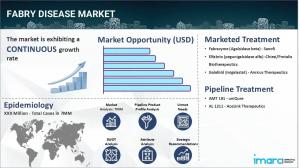Fabry Disease Market Size to Reach USD 3,898.0 Million by 2035 - Epidemiology Report by IMARC Group
The Fabry disease market report provides a detailed analysis of the current marketed drugs and late-stage pipeline drugs, advancements in treatment.
BROOKLYN, NEW, UNITED STATES, July 1, 2025 /EINPresswire.com/ -- The Fabry disease market size was valued at USD 1,637.7 million in 2024. Looking forward, IMARC Group expects the 7MM to reach USD 3,898.0 Million by 2035, exhibiting a growth rate (CAGR) of 8.20% during 2025-2035.In 2025, the Fabry disease market feels like it is finally catching up to the promise everyone has been talking about for years. This rare genetic condition happens when the alpha-galactosidase enzyme is missing or working poorly, and that small flaw can slowly hurt the heart, kidneys, and nerves. Doctors used to rely mainly on regular enzyme replacement infusions, but fresh options are on the table now, and many of them make daily life easier. Right now, the hottest idea is gene therapy, and the buzz around it is hard to ignore. New studies are testing tiny viral delivery systems that slip a working version of the enzyme gene into patient cells. If these one-time treatments do what researchers hope, patients might trade endless infusions for a single IV and keep enzyme levels steady for years. Early trial results show encouraging signs of that long-lasting activity, so the whole treatment mindset could be on the verge of a major upgrade.
In 2025, taking medicine is getting a lot easier because new pills for Fabry disease are on the way. Scientists now have oral chaperones and substrate-reduction drugs that sit in the stomach, calm the glitchy enzyme, and lower the nasty buildup inside cells. Those easy-to-swallow meds work alongside the standard enzyme infusions, giving families a more flexible and gentler way to stick to treatment. Doctors, nurses, and patients are all cheering for this change because it cuts drama and boosts everyday life. Wider screening and better money plans are also shaking up the global market. Many Asian, Latin American, and European nations have supercharged newborn tests and lined up fresh insurance rules so more babies are spotted early and stronger meds land on more pharmacy shelves. Advocacy groups are pushing hard, telling stories that reach lawmakers and making sure the policies really happen. Care teams are thinking bigger too. In 2025, doctors, nurses, dietitians, and counselors sit at the same table, tracking hearts and kidneys while also chatting about fears, school, and exercise. This full-circle plan treats the whole person, not just the disease, and helps families build a normal, hopeful future.
A significant trend this year is the rising focus on gene therapy. Emerging research programs are exploring viral-vector strategies that deliver functional copies of the missing enzyme gene. These one‑time treatments hold the potential to reduce long‑term therapy burden and maintain enzyme activity more reliably than biweekly infusions. Clinical trials are showing early clinical signs of sustained enzyme presence, marking a pivotal shift in therapy philosophy.
Another major development in 2025 is the advancement of oral therapies. Oral chaperones and substrate reduction agents are being refined to stabilize the faulty enzyme and reduce harmful substrate in cells. These oral options complement existing enzyme treatments and offer patients more flexible, less invasive alternatives. Patients and clinicians alike are welcoming this shift toward improved quality of life and adherence.
Broader access is also transforming the global market. Countries across Asia, Latin America, and Europe are strengthening newborn screening programs and expanding reimbursement frameworks. These efforts are helping diagnose more patients early and ensure treatment is more widely available. Support from patient advocacy groups is playing a crucial role in raising awareness and driving policy changes.
Finally, holistic care models are gaining traction. In 2025, multidisciplinary teams are emphasizing not only medical management but also comprehensive support services. Regular monitoring by cardiologists and nephrologists, alongside psychological counseling and lifestyle advice, reflects a more rounded approach to living with Fabry disease.
Request to get a PDF Sample Report: https://www.imarcgroup.com/fabry-disease-market-report/requestsample
Key Highlights:
Fabry disease affects 1 in 40,000 to 1 in 117,000 live births globally, with potentially higher prevalence in certain regions like India.
X-linked disorder; sons of carrier mothers have a 50% chance of inheritance, while daughters have a 50% chance of being carriers.
Classic Fabry symptoms appear in childhood, including burning pain and skin lesions, while late-onset cases emerge in the 30s or 40s.
Males live about 58 years (vs. 75 general population), females about 75 years (vs. 80 general population), with organ complications affecting survival.
Lipid accumulation causes kidney failure, heart disease, and strokes, increasing risks of cardiovascular and renal complications over time.
Competitive Landscape
The competitive landscape of the Fabry disease market has been studied in the report with the detailed profiles of the key players operating in the market.
Sanofi
Chiesi/Protalix Biotherapeutics
Amicus Therapeutics
uniQure
AceLink Therapeutics
Buy the full Fabry Disease Treatment Market Epidemiology Report: https://www.imarcgroup.com/checkout?id=30204&method=809
7 Major Countries Covered
United States
Germany
France
United Kingdom
Italy
Spain
Japan
Elena Anderson
IMARC Services Private Limited
+1 631-791-1145
email us here
Legal Disclaimer:
EIN Presswire provides this news content "as is" without warranty of any kind. We do not accept any responsibility or liability for the accuracy, content, images, videos, licenses, completeness, legality, or reliability of the information contained in this article. If you have any complaints or copyright issues related to this article, kindly contact the author above.

